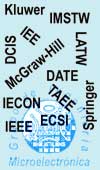
Mapa Web

Localización

Noticias

Info Santander

Gestión BD

|
| GIM>Investigación>Publicación |
| PUBLICACION |
| |
| Ficha completa |
| Título: | Optimized Coverage-directed Random Simulation |
| Tipo: | Publicacion en Proceedings o Actas internacionales |
| Lugar: | IEEE International High Level Design Validation and Test |
| Fecha: | 2008-11 |
| Autores: |
Iñigo Ugarte
Pablo Pedro Sánchez
|
| Líneas: |
|
| Proyectos: |
|
| ISBN: | 9781-4244-2922-6 |
| Fichero: |
|
| Resumen: | Due to the growing complexity of modern digital systems, functional verification is still an important challenge. Current verification practice in industry and in academia includes simulation and formal techniques. While formal tools can handle small to medium size designs, only simulation-based tools can validate digital systems of almost infinite complexity. One of the main disadvantages of simulation is that only one set of behaviors is explored. In order to improve simulation, several coverage metrics have been proposed. These metrics (such as line, path or conditional coverage) provide information about the variety of behavior that a particular test-bench explores. With modern digital systems, it is difficult to obtain high coverage, thus a key challenge, according to the latest report of the ITRS, is to create new solutions that can provide high coverage at all hierarchical levels of a design. Verification plans commonly use random test bench generation. However, this technique normally provides a low coverage that is not improved by increasing the number of test-benches.
The main contribution of this paper is the development of a behavioral verification technique that enables the improvement of the coverage of random test-benches. The algorithm takes advantage of the structure of the behavioral system description and the information that the simulation produces.
|
|
|








